Strategic Planning Summary:
Strategic planning is a deliberate process aimed at shaping the future priorities of a nonprofit organization. It hinges on the active involvement of key stakeholders, such as staff members, significant donors, strategic volunteers, and the board, who collectively evaluate the nonprofit’s mission and vision. The objective is to discern and prioritize the most crucial actions required for advancing these objectives over the next 3-5 years, achieved through the establishment of foundational strategic pillars, objectives, and key performance indicators (often referred to as goals, priorities, or KPIs).
For a nonprofit strategic planning process, these are the two critical deliverables:
- Strategic Plan
- Tactical Plan
What is the difference between a Strategic Plan and a Tactical Plan?
A strategic plan and a tactical plan serve distinct roles in nonprofit planning. A strategic plan is a high-level, long-term document that outlines an organization’s overarching goals and strategies, focusing on the mission, vision, and values. It provides a broad roadmap for the organization’s future and is typically reviewed and updated periodically, covering a span of three to five years or more. Often, this document, in its end state, will be beautifully designed, showcased on the website, and used with donors, key volunteers, and influencers to cast vision and belief.
In contrast, a tactical plan is a more detailed, short-term document that translates the strategic plan into specific tasks and activities. In other words, it’s creating an actionable workflow. It is highly specific, focuses on day-to-day, and is usually crafted for one year or less. Tactical plans provide the actionable steps necessary for executing the strategies outlined in the strategic plan.
In essence, strategic plans set the organizational direction and long-term vision, while tactical plans offer the precise guidance and actions required to achieve short-term objectives, making both types of plans crucial components of effective organizational planning and execution.
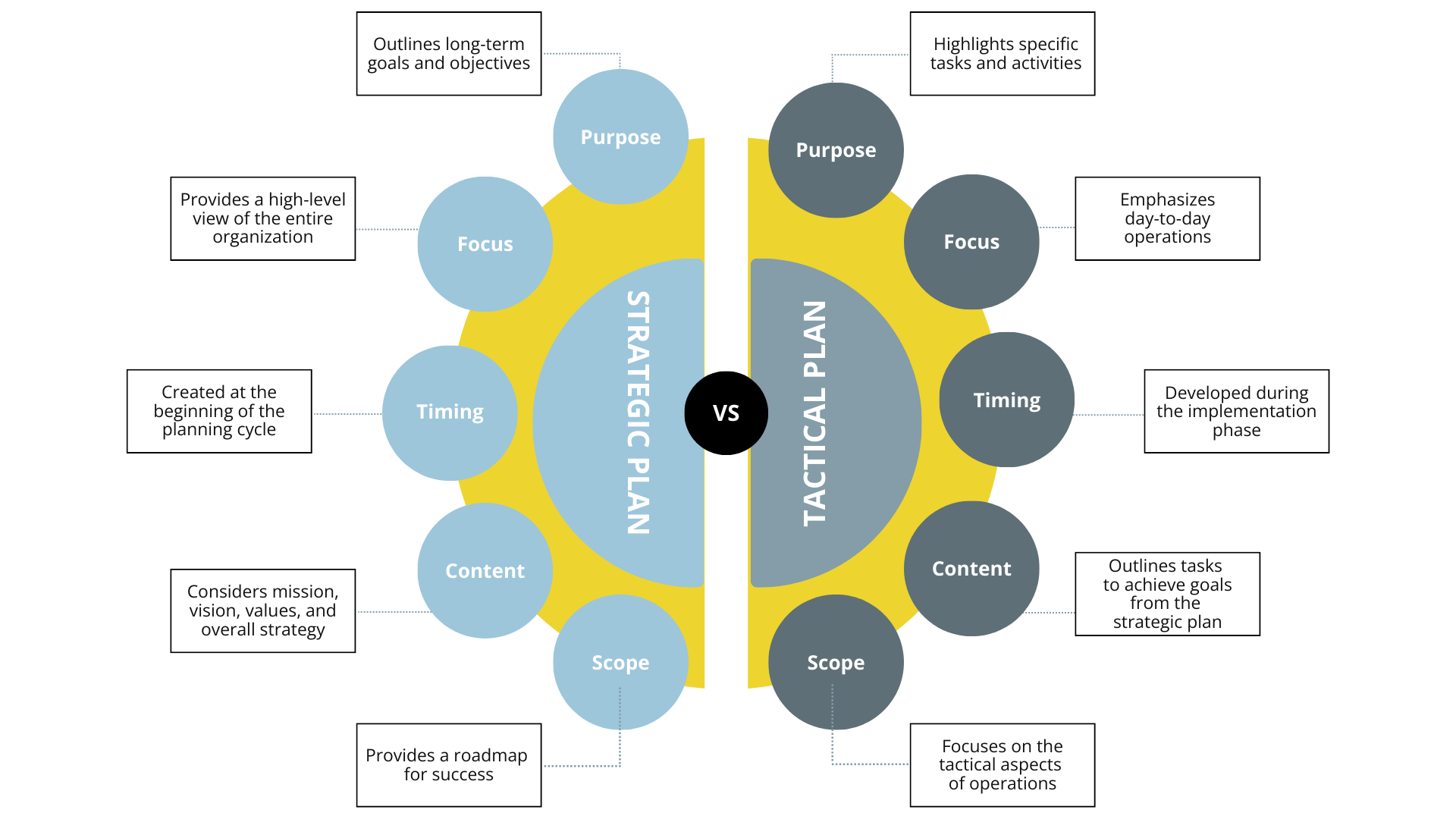
Important Insight about Strategic Planning:
The typical strategic planning process employed by many consultants in the nonprofit sector results in an aesthetically pleasing PDF document that is presented to the board and potential donors. However, most do not include a Tactical Plan that encompasses change management strategies and well-defined Key Performance Indicators (KPIs). Having a strategic plan alone is insufficient; it must be complemented by a tactical plan featuring clear timelines and measurable benchmarks. When engaging a consultant to lead your nonprofit’s strategic planning process, it is crucial to request examples of tactical plans they have previously assisted in creating.
3 Nonprofit Strategic Planning Templates
At Catapult, we emphasize the creation of winning strategies over mere strategic plans. We believe it is not enough for a plan to merely look impressive on paper; there must be a seamless integration between a visually appealing Strategic Plan that gives a roadmap for success and a well-executed Tactical Plan that ensures success.
To assist nonprofit organizations in this endeavor, below are three templates that have proven valuable for many.
As every nonprofit organization is unique, with its distinct opportunities, challenges, mission, and DNA, each strategic plan is inherently distinctive. The purpose here is to provide you with 3 template models on how to approach your planning process before delving into the specifics. A visual of each strategic planning model that incorporates both Design and Accountability in included, recognizing that both elements are essential for effectively implementing your strategic plan.
After all, what good is a winning strategy on paper if there is no effective mechanism to bring it to life?
Catapult Strategic Planning Template
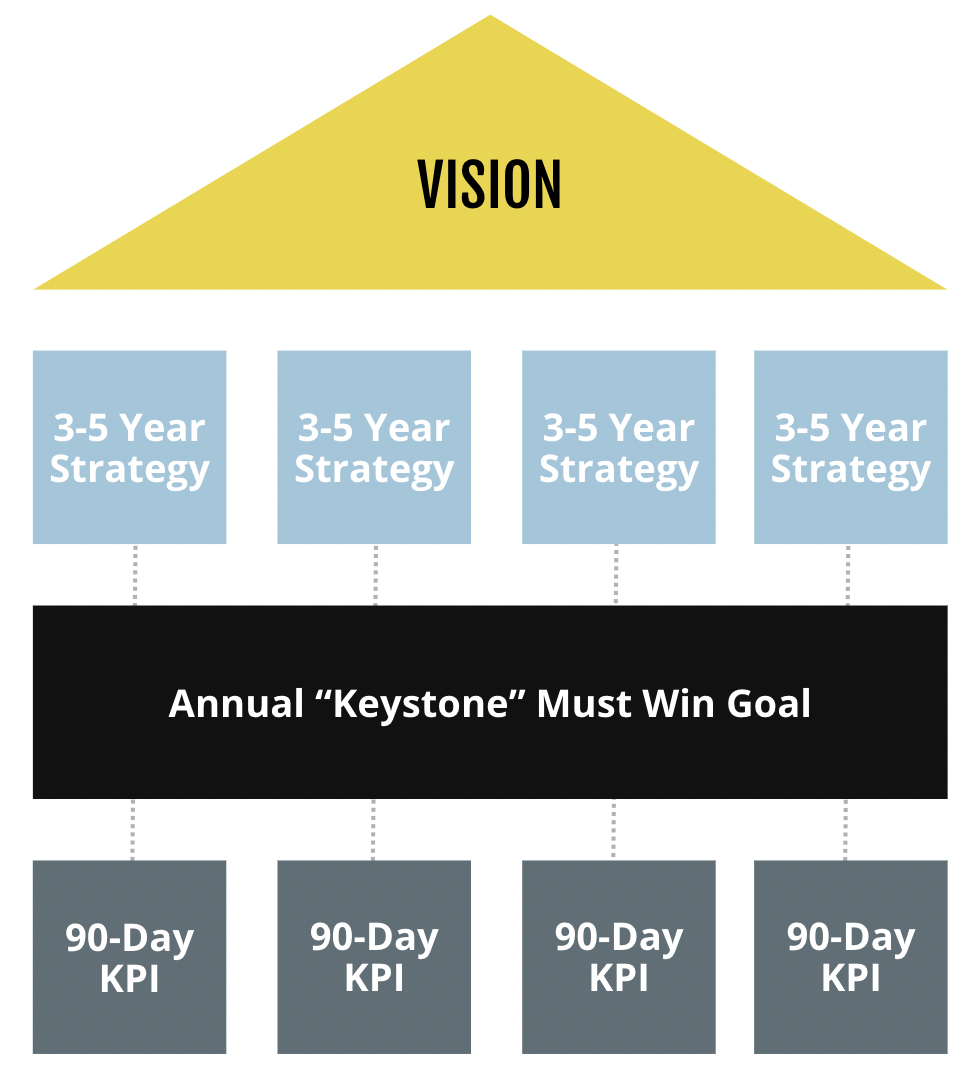
The design blocks of the Catapult Strategic Planning Template:
- Vision
The Catapult strategic planning model begins with the foundational element: your Vision, which represents a distant horizon guiding everything below it. What sets this model apart is its deliberate approach to steering an organization toward a preferred future (vision) with intentionality rather than relying on chance. - 3-5 Year Strategies
Moving forward, you transition to the 3-5 Year Strategies, which provide high-level summaries of your qualitative and quantitative goals. These serve as a broad roadmap for your organization’s aspirations, giving four foundational pillars for your strategy. - Annual “Keystone” Must Win Goal
Beneath these strategies, you define one Annual “Keystone” Must Win Goal. This is a unique fixture of this planning process and serves as a clever and sophisticated method for rallying the entire organization towards a goal where every member contributes significantly, exerting an outsized influence on progress across various strategic areas. It operates somewhat akin to a domino effect; once this Annual Goal is achieved, it sets off a chain reaction of strategic progress. - 90-Day Key Performance Indicators (KPIs)
Lastly, you pinpoint your 90-Day Key Performance Indicators (KPIs). These represent the specific actions you will take to reach your Annual Must Win Goal, always with an eye towards the larger strategic pillar to which it is attached. These emphasize the importance of measurability in tracking progress and holding team members accountable to advancing the mission.
The accountability mechanisms of the Catapult Strategic Planning Template:
- Weekly Check-ins:
These check-ins revolve around the 90-Day Key Performance Indicators (KPIs) and entail KPI owners delivering quick progress updates. The purpose is to keep these items on the front-burner. While a Weekly Check-in is encouraged, the model can function without them. - Monthly Reviews:
The Monthly Reviews are designed to help team members track progress towards the Annual Objectives and are longer check-ins. Goal owners’ updates contribute to an understanding of how everyone is moving forward and highlight any obstacles that need to be overcome. - Quarterly Refresh:
During the Quarterly Refresh, the KPIs from the previous quarter are reviewed and the new 90-Day KPIs are established. This phase also involves designating the responsible “owner” for each goal. - Annual Reviews:
Annual Reviews are likewise centered on the Annual Objectives, occurring at the conclusion of the timeframe. A chunk of time is spent debriefing the learning from the previous goal before setting the new Annual “Keystone” Must Win. These reviews involve a critical decision point regarding whether to mark an Annual Objective as completed or to carry it forward into the next year.
Catapult Strategic Planning Template Summary
This Strategic Planning Template integrates a vision-driven approach with clear, intentional progression. It begins with the Vision, guiding the organization’s strategic layers. From there, leaders define high-level 3-5 Year Strategies and an Annual “Keystone” Must Win Goal, acting as a catalyst for organizational progress. To ensure accountability and progress, Weekly Check-ins and Monthly Reviews against KPIs and Annual Objectives keep everyone on track. The Quarterly Refresh fine-tunes the strategy in real time, while Annual Reviews provide a crucial decision point for completing or rolling over Annual Objectives. This model combines vision with practicality, creating a dynamic roadmap for a nonprofit’s success. Finally, nonprofit leads are not left to choose between a Strategic Plan or a Tactical Plan that activates your strategy into day-to-day workflow. This comprehensive planning process includes both.
OKR Strategic Planning Template
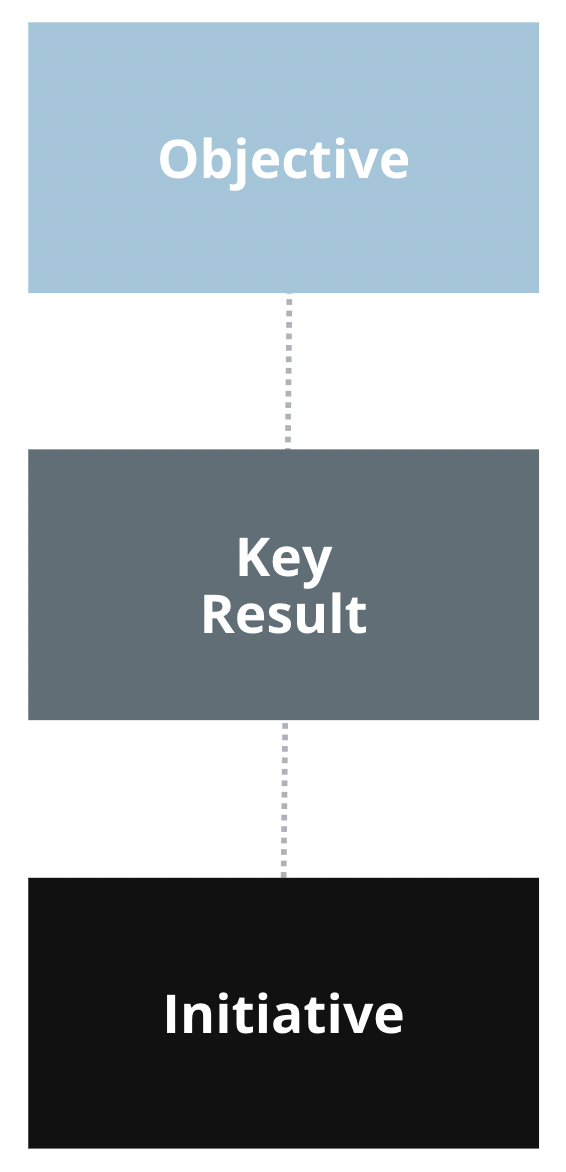
The Design blocks of the OKR Strategic Planning Template:
- Objectives:
In the context of organizational planning, Objectives represent the specific outcomes that an entity aims for during the current quarter. These objectives are essentially the milestones or targets that define success for that period, offering a clear sense of purpose and direction for the team’s efforts. These are sometimes referred to as lead indicators. - Key Results:
Key Results are tangible, quantifiable metrics that provide a numerical assessment of progress toward the stated Objectives. These metrics serve as a means of objectively measuring success and tracking performance. Key Results offer valuable insights into the effectiveness of the strategies in place, helping teams make data-driven adjustments as they work toward achieving their Objectives. These are sometimes referred to as lag indicators. - Initiatives:
Initiatives are the actionable tasks or projects strategically aligned with achieving the Key Results. They represent the practical steps and efforts undertaken to directly influence and contribute to the achievement of desired outcomes. Initiatives act as the operational components of the overall strategy, outlining the specific actions and tactics necessary to make measurable progress and, ultimately, achieve the defined Key Results.
The Accountability mechanisms of the OKR Strategic Planning Template:
- Weekly Check-Ins:
Weekly Check-Ins, integral to the OKR (Objectives and Key Results) management framework, provide a structured platform for meticulous Key Result assessments. Team members should scrutinize their confidence levels in what they are working on, dissect action plan progress intricacies, and exchange insights on overall advancement. This fosters proactive OKR execution, facilitating swift issue identification and timely adjustments. All of this ensures that stakeholders maintain alignment and in-depth awareness of evolving OKR dynamics. - Quarterly Review:
The Quarterly Review, an evaluation mechanism within OKR, subjects each Objective to an assessment, yielding a numerical “score” (typically 0 to 10) that encapsulates multifaceted achievement status. This process sparks intricate deliberations determining the trajectory for each Objective in the upcoming quarter. This includes refinement, continuation, or discontinuation. This also ensures an agile OKR strategy capable of addressing intricate circumstances and priorities that are regularly evolving.
OKR Strategic Planning Template Summary
The OKR (Objectives and Key Results) model, as discussed in the points above, is a structured approach to goal-setting and performance measurement. The key to the process is stringent Weekly Check-ins and reviews, which introduces a level of administrative overhead for individuals and teams. One potential downside in the model is the Quarterly Refresh can lead to frequent changes in objectives, potentially disrupting ongoing day-to-day work. Finally, the Annual Reviews require thorough assessment and decision-making regarding the continuation or adjustment of objectives, adding a formalized process to the annual planning cycle.
Balanced Scorecard Template
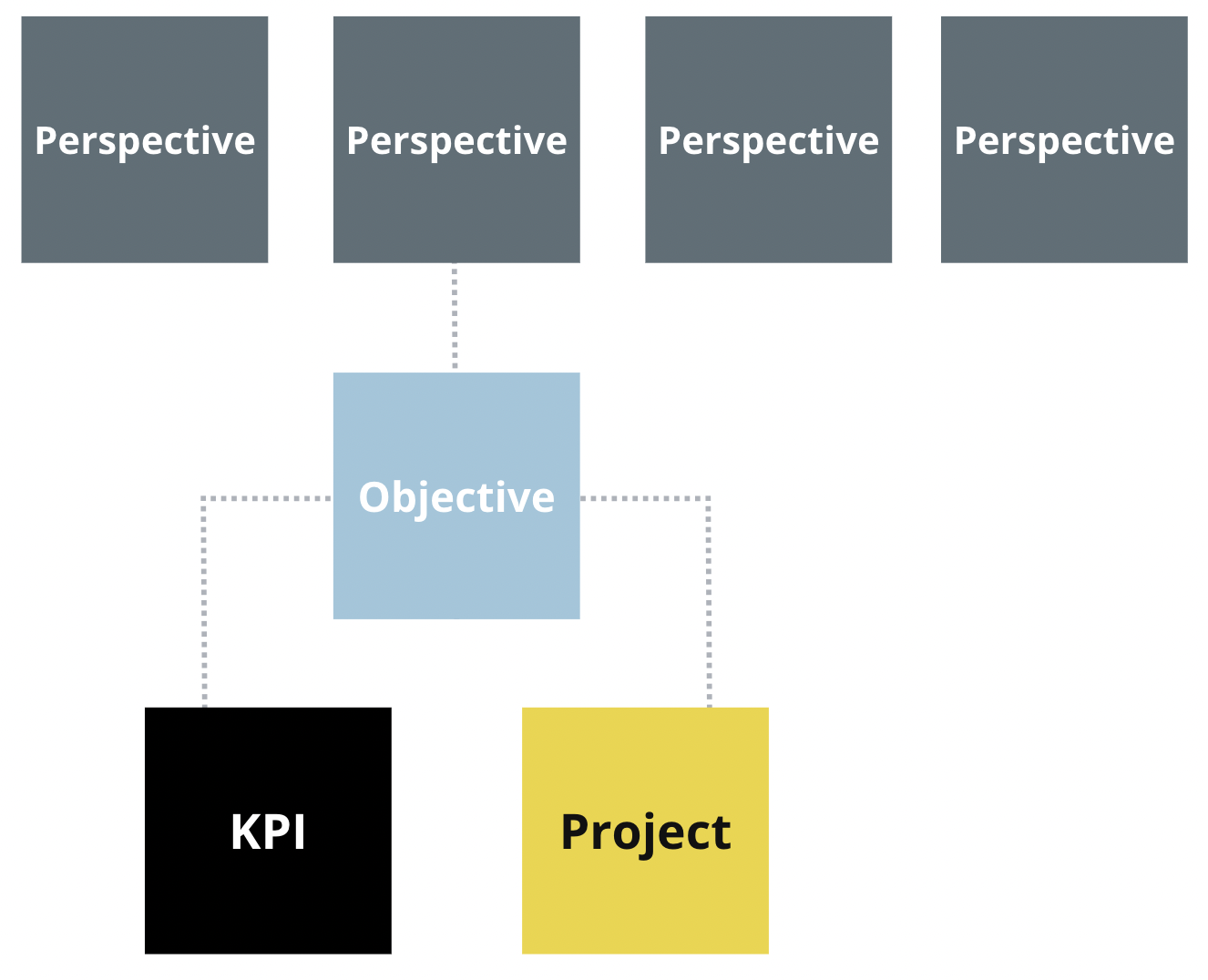
The design blocks of the Balanced Scorecard Template:
- Four Perspectives
These serve as focus areas for growth for the nonprofit and can be internally focused or externally focused. Sometimes they act as fulcrums for strategy, sometimes they are important projects within the organization that will take several years to build out (such as team culture, new board structure, etc). The perspectives are meant to complement each other in a holistic way and “balance” each other out. - Strategic Objectives
This is an articulation of the strategy of the perspective it is attached to. This should include specific, measurable outcomes of what success looks like for this strategic objective if progress is being made. - Projects
The project operates as a kind of workflow for different pieces of the strategy. It outlines the specific initiatives, timelines, ownership and allocated resources necessary to achieve the goals outlined in the strategic objective. - KPIs
These are the key measurables that are lag indicators of whether the strategic objective it is attached to is moving forward. If the strategic objective has the lead indicators that the plan is working, the KPIs are the more granular measurables that indicate all of the work will tip the scale for the strategic objectives success.
The accountability mechanisms of the Balanced Scorecard Template:
- Strategy Dashboards
This offers an invaluable tool for keeping everyone in the loop, enabling you to visualize real-time progress and keep an eye on your key objectives, projects, and KPIs effortlessly. Preferably this would be mapped out and trackable through a project management platform like Monday, Asana, Trello, BaseCamp or whatever your nonprofit is currently using. - Weekly or Monthly Reports
These reports provide a structured way for team members to share their progress updates and lay out short-term action plans, fostering collaboration and transparency. Typically these can be downloaded from your project management platform, turned into a PDF, and shared with the wider team. In a meeting setting, this includes commentary and status updates from the owner of the action items. - The Strategy Map
This serves as a visual compass, revealing the interconnectedness of the four perspectives and the cause-and-effect relationships between your strategic objectives. This is meant to guide your organization towards a more cohesive and effective strategy implementation.
Final Thoughts on Strategic Planning
If you’re feeling overwhelmed by the idea of starting a strategic planning process with the nonprofit you help lead, we get it! It’s an important time in the life of any nonprofit and it can be a difficult journey. We would love to help you find a guide for that process. Whether that is Catapult helping you lead this journey or pointing you to a better fit, we would love to serve you.
Ready to design your own winning strategy?
Catapult’s published The Ultimate Strategic Planning Black Book to help nonprofits like yours take the first steps towards developing a rock-solid strategic plan. Join our email list to get the guide now.
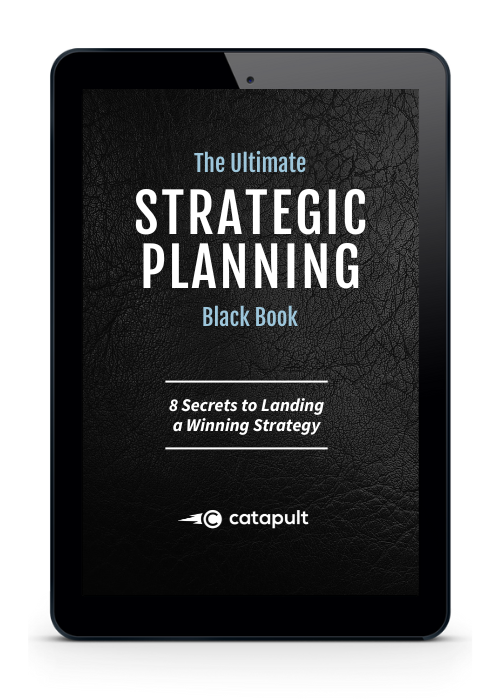
Additional Articles on Strategic Planning
8 Strategic Planning Tools That Organizations Often Use to Facilitate the Strategic Planning Process
When organizations are walking through a multi-month strategic planning process with a nonprofit consultant, there tend to be a variety of tools that get pulled out of the facilitation tool belt. In our work with 1300+ nonprofit organizations, we have found that...
The 10 Best Nonprofit Consultants & How to Choose The One That Is Right For You
In the realm of nonprofit organizations where every dollar donated is a potential lifeline for a cause, the expertise of nonprofit consultants can shine like a guiding star. Their goal is to work behind the scenes using their knowledge and experience to help...
5 Mistakes Nonprofits Make When Hiring a Consultant
In the complex world of nonprofits, hiring a consultant can feel like trying to figure out how to summon a wizard to solve your organization's most pressing challenges. While consultants possess a particular expertise, nonprofits can sometimes stumble into avoidable...




